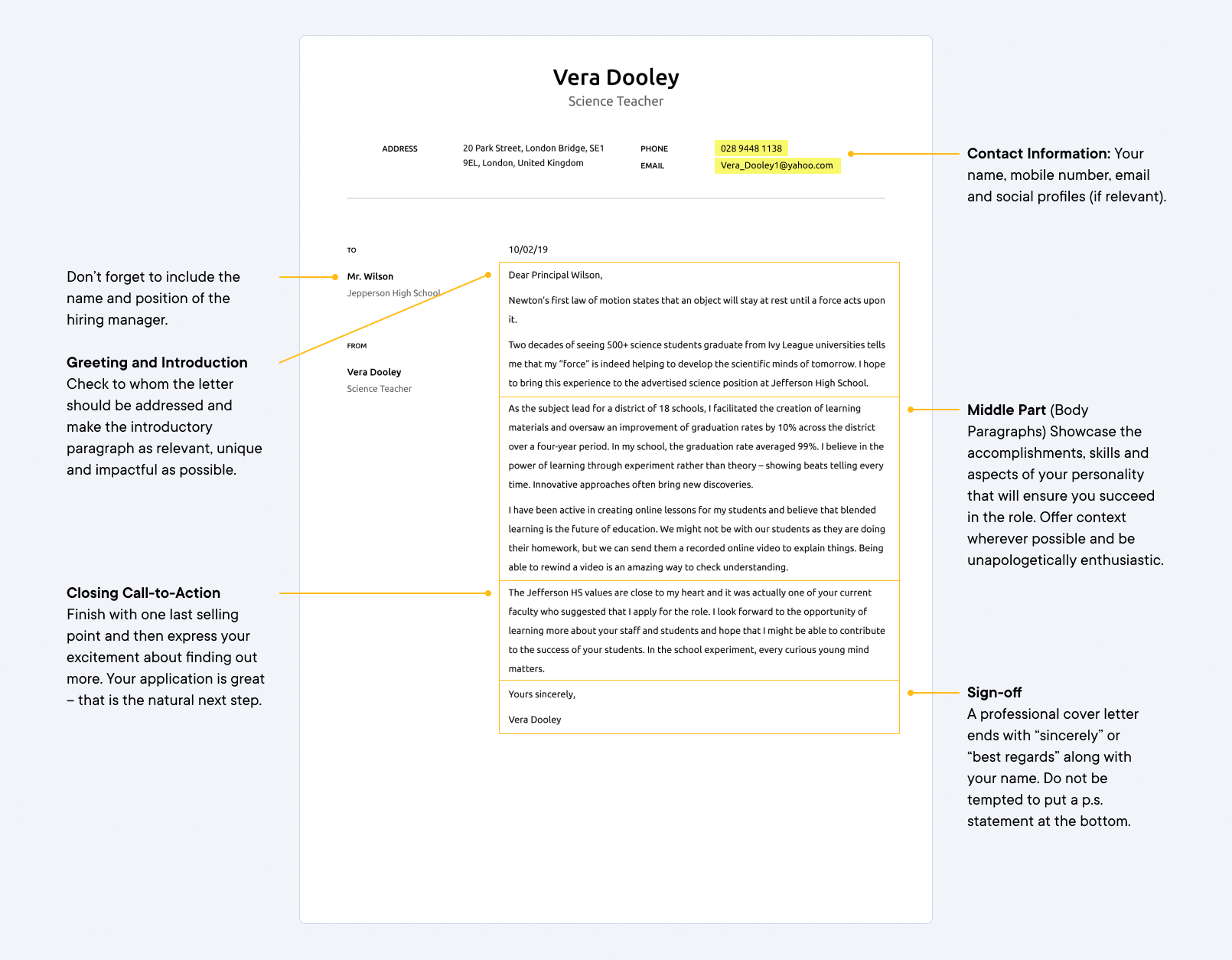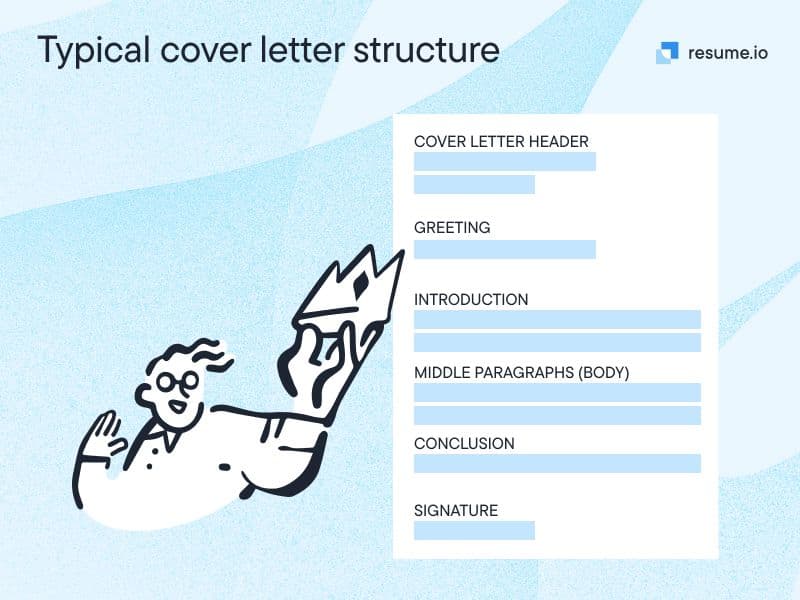
Writing a cover letter isn’t just about choosing the right words—it’s also about how you present your career story. A well-structured cover letter layout and format can bring clarity, confidence, and professionalism to your message, helping you stand out in a competitive job market.
In this blog, we’ll explore what makes a strong cover letter format, from layout ideas and essential formatting tips to best practices for presenting your cover letter in an email.
By creating a clear and visually appealing structure, you’ll give your cover letter the best possible chance of making a positive impact on the hiring manager.
The perfect cover letter format
Here’s what a great cover letter layout looks like:

How to format a cover letter
While a covering letter layout can vary slightly between sectors, there is a widely accepted structure across most UK industries. Employers typically expect certain key details to be included, along with a clear and logical presentation of your career story.

Cover letter header

Your cover letter format should begin with a clear header that includes the following details:
- Full name. This should be the most prominent element. Use bold text and a slightly larger font size to ensure that it stands out.
- Mobile number. Provide a reliable contact phone number where you can be easily reached with a professional voicemail greeting. Add the area and international dialling code if you’re applying to an international firm.
- Email address. Avoid using a quirky or unprofessional email address. Instead, use a simple format such as firstname.lastname@email.com.
- Online profile (optional). Include a link to your LinkedIn profile, personal website, or digital portfolio if relevant to the role. If you can, make the link short and/or easy to remember in case your cover letter is passed along in printed form.
Many cover letters also include the employer details after the date of the letter. This can simply include the name of the hiring manager and company name. But if you are sending a formal letter in the post, you can of course include the full company address.
Cover letter greeting
Your cover letter should open with a personalised greeting whenever possible. Check the job description or company website for the hiring manager’s name, or call the organisation to ask who is overseeing recruitment for the role. It’s a small step that can leave a strong impression.
If you’re unable to find a specific name, “Dear Hiring Manager” is a professional and acceptable alternative. Try to avoid outdated phrases such as “ Dear Sir or Madam” or “To Whom It May Concern,” as they can feel impersonal and old-fashioned.
- Use a professional font. Choose a standard font like Arial, Calibri, or Verdana.
- Maintain proper spacing. Set margins between 0.5 and 1 inch, with single-line spacing and a line between sections.
- Save your cover letter in PDF or Docx format when sending a digital copy, unless the recruiter specifies otherwise.
- Exceed one page. Keep your cover letter short and sweet—ideally 250 to 400 words.
- Reduce font size in order to fit more content in your one-page cover letter. Stick to an 11-point or 12-point font size.
- Choose an elaborate file name. Your full name, job title, and the words “cover letter” are all you need.
Cover letter introduction
Start your cover letter with a striking and relevant opening paragraph that immediately captures attention. This could include a noteworthy accomplishment, a personal anecdote, a connection to the organisation, or a shared value that motivated you to apply for the role.
Incorporating strong action verbs or compelling statistics will help your achievements resonate more powerfully. The more context you provide, the more vividly you will spark the imagination of your prospective employer.
While managing a student charity fundraiser that exceeded its target by 40%, I realised the power of effective messaging. That experience fuelled my passion for marketing and is a key reason I’m excited about the opportunity to join [Company Name], where community-driven branding turns audiences into active participants.
Cover letter main body
The middle part of your cover letter format should delve deeper into your accomplishments and demonstrate how you align with the company’s culture. This is your chance to speak directly to the hiring manager in a more personal, conversational tone.
Consider the following questions:
- Why should they hire you?
- Why are you interested in working with them?
- What sets you apart from other candidates?
In answering these questions, use more action verbs to describe your skills, be precise about what you’ve achieved, and quantify the results from your previous employment. Your past successes are a strong indicator of future potential, and crafting a compelling narrative can lay the foundation for a successful interview.
As the author of your own cover letter, you have the power to steer the conversation—so think carefully about what story you want to tell.
In my current role as an IT educator at Greenfield Secondary School, I developed a coding curriculum that increased student proficiency by 15%. I integrate emerging technologies into lessons, foster collaborative learning, and provide tailored support to students with diverse needs—skills I am eager to bring to [School Name].
Cover letter closing
End strong with a cover letter conclusion that leaves a lasting impression. A compelling ending ensures that you're remembered long after the hiring manager moves on to the next candidate.
Here are the key elements to include:
- Revisit the hiring manager's underlying requirements one final time.
- Align your personal motivations with the company's mission or values.
- Employ repetition to reinforce your key message.
- Introduce a narrative you'd like to expand upon in the interview.
Don’t forget to include a call to action, such as a polite request for an interview and the opportunity to discuss how you can contribute to the organisation's success.
Following graduation, I would love to work for a forward-thinking company like IT World, where I can increase my experience and deliver optimal support to your clients. I look forward to the opportunity to meet with you to discuss my ideal fit for this exciting opportunity in more detail. Thank you for your time and consideration.
How to format an email cover letter
If you’re applying for a role outside of a formal process and have been asked by the hiring party to send your cover letter in an email, then you’ll need to format this differently.
This is not an approach we typically recommend, as emails can be lost and cover letters shared in the body of an email cannot be easily stored on applicant tracking systems (ATS) for others to read.
However, if you do opt to email your cover letter layout, here are the elements you need to consider:
- Email subject. You want to entice the recruiter to click through to the body of your email, but avoid creating an over-elaborate subject title. Using the title of the role you’re applying for and your name is perfectly fine.
- Greeting. As with any cover letter, personalise this by using the hiring manager's name.
- Introduction. Emails don't have the luxury of space quite like a cover letter document. Aim to make your email cover letter about 30–40% shorter than the PDF version. Start with a punchy one-liner that gets straight to the point and clearly communicates your value.
- Main body. Think of this as your elevator pitch. Use four to five lines to highlight your most relevant achievements and show how your skills align with the role. Demonstrate your value and personality in a concise, engaging way.
- Closing and call to action. Wrap up by reinforcing why you're a strong fit for the role and express enthusiasm about the opportunity. Politely suggest the next step, such as scheduling an interview, and convey your eagerness to discuss your application further.
- Contact information in the footer. Since email cover letters differ from PDF versions, include your contact details—email, phone number, LinkedIn, or portfolio links—at the bottom of the email after your sign-off so that the hiring manager can easily reach you.
Cover letter layout example
Below is an example of an ideal cover letter layout to give you some inspiration. At resume.io, we also have a library of 100+ cover letters that can be modified to suit any position.





